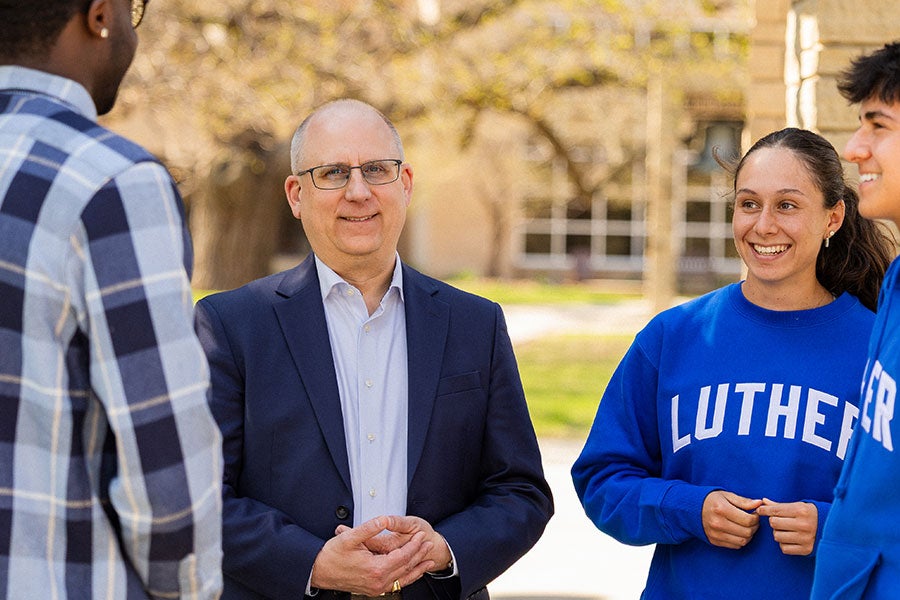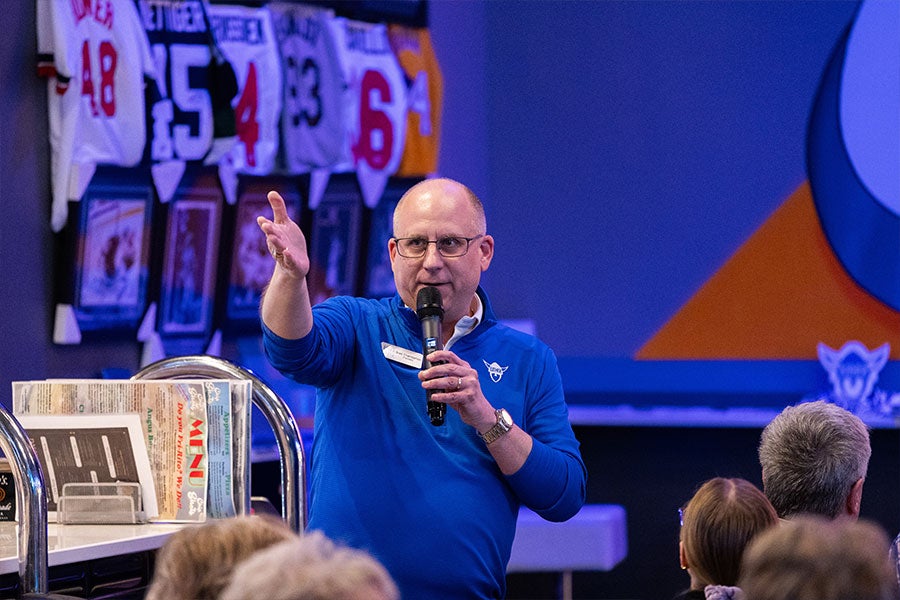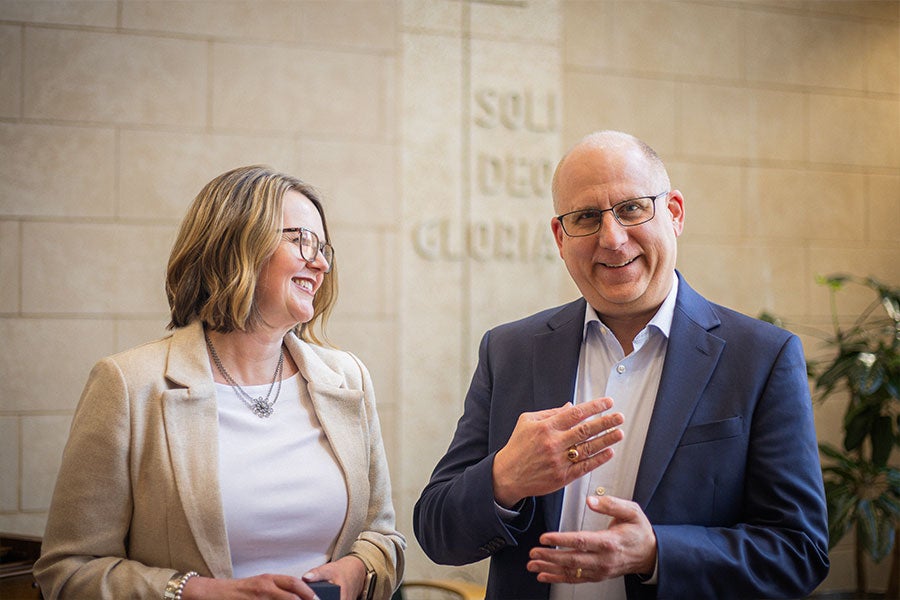Meeting the Moment Together
Brad Chamberlain became Luther’s 12th president in February. A graduate of Gustavus Adolphus College, he has a 24-year history at Luther, first teaching chemistry, then serving as dean for institutional planning and mission, vice president for mission and communication, and provost. He is the husband of Julie (Torkelson) Chamberlain ’96 and father of Drew ’26 and Liam ’29. This spring, we sat down with President Chamberlain to get a sense of why he’s taken this path, where things stand with Luther College, and where he sees things headed in the future.

Why did you decide to teach—and now lead—at a liberal arts college?
When I was an undergraduate at a liberal arts college, I discerned a call to teach in that setting. Nevertheless, the topic of my doctoral research at the University of Minnesota was industrially focused, and I was seeking an industrial position when I accepted a postdoctoral appointment at Cornell University in upstate New York. During that appointment, I began to question my path toward industry. One day I came home from my lab and found in our industry magazine an ad to teach at Luther College. It was the one time it was advertised. They advertised it for one week. I had not looked at that magazine in six months. I just happened to see it that day, and I felt a distinct call. Within a couple of weeks, I was on a plane to start here in a one-year position. It’s turned into 24.
Over those 24 years, as I was given opportunities to be involved in campus-wide projects and roles, I found a deep interest, fulfillment, and energy in thinking at the institutional level. One of the things I’ve appreciated about Luther is that it’s created spaces for experiential learning not only for students, but also for staff and faculty. I’ve been able to step into places that were unfamiliar to me, and I was given the grace and support to learn and discover in each of those spaces.
When you became president, you articulated four words that will be the four points of our compass: Honesty and Hope. Pride and Belief. Could you talk a little bit about those words?
When I talk about those four words, I use them in pairs. I pair “honesty” with “hope.” I pair “pride” with “belief.” Because while each of those words has merit in its own independent usage, I see connections within the pairs. I see how being forthright and honest about our circumstances actually can help us build hope rather than diminish it. And I see how expressions of pride translate into a sense of belief.
It’s a difficult time to be honest, because higher ed is in a struggle.
It is. We’re having a moment. But when you look at one of the books about our college history, Stability and Change, this is just another chapter. The community has been through this before. No one’s eager to be in these moments. But we have a long history of being able to meet the moment. And I think our ability to meet it really is based upon those four words.
I see a distinct difference between anticipatory hope and participatory hope. I think most people conceive of hope in the anticipatory way—wishful-thinking that we’ll change. I see a need for participatory hope—the type of hope that rolls up its sleeves rather than crosses its fingers.
The way that we participate in hope is informed by honest reflection about what our challenges are and what our strengths are. By engaging honestly in participatory hope, we build that sense of pride and that feeling of belief.
What are the priorities you want to embrace in your first year of presidency?
There are many, and in addition to those four words, “community” is another. We are in this new chapter, but it has to be our chapter. It has to be a “we” moment rather than a “me” moment. I have a key role in it, but the work is so profound that it has to be a collective effort. So we’re really focusing on reconnecting individuals within the community, reconnecting Luther to Decorah, reconnecting alumni to the college in new and meaningful ways.
The other word I’m using a lot is “focus.” There are so many things we could do, and not all of them are going to impact our well-being as an institution in the same way. So what are those things in the next one year, two years, five years that we can do that will have the biggest impact on our ability to thrive in this moment?
Higher ed institutions—and Luther is no different—sometimes try to make the best 20-year decision. But things are moving so quickly right now that trying to think in a 20-year timeframe can paralyze us, because we’re humans and we can’t actually predict what’s going to happen in 20 years. So I’m trying to think about what we can do to help us advance in six months and then one year and then five years. And giving ourselves the freedom to change our approach based upon our learning.
Sometimes that means being more comfortable with ambiguity. More willing to run experiments, take thoughtful and calculated risks, and not seeing personal or institutional failure when things don’t go exactly as planned, as long as we’re learning from it. If things don’t work, how can we learn from that and adapt?

In April, President Chamberlain met with alumni and friends in Rochester, Minnesota.
What makes Luther different from other small residential colleges?
Luther draws out excellence. We push every student out of their comfort zone, beyond what they thought might have been possible for them. Many institutions base their reputation upon how students arrive. I see Luther basing its reputation and impact upon how students leave. We look within students and say, “Here’s something we see in you that you may not see in yourself. Let’s draw that out.” I hear story after story about how students never thought a pathway was open to them until someone spoke it into reality.
Another differentiating aspect of Luther is the ability of our students to connect across differences. It’s a key aspect of the sense of community we have here. Our students can appreciate other perspectives and find ways to be in community even with those with whom they disagree. We intentionally cultivate that ability in our first-year Paideia program and then continue to develop it through their remaining years of classes and co-curricular activities.
Something else I emphasize is how Luther graduates have an inordinate impact upon their communities. When I travel, as much as possible I travel with Luther gear on. And almost invariably someone stops and talks with me about it—and not just alums. There are people who don’t have a formal connection to the college, but they want to tell me about the Luther person in their life. That’s meaningful for me. I don’t think that happens at other places. I see Luther graduates not just wanting to be the best individual contributor in their organization—they want to be in the best community. So they find ways to improve their community. And in so doing, they stand out.
Finally, our alumni community is particularly engaged and passionate, as is our Decorah community, as is our faculty emeriti community. I don’t hear that level of engagement and passion at other institutions. An education at Luther is a transformation, not a transaction. You know you have a transformational environment when people want to stay connected to it. Whereas at many other institutions, it’s a transaction—people are going there, paying their tuition and room and board, getting their credential, and moving on with their life. They don’t feel a lot of affinity for their educational community. That’s not been Luther’s story.
What do you think is ready for change at Luther?
We’re going to have to be more explicit in defining and articulating our value proposition, especially in this moment when confidence in higher ed is mixed. We’re going to need a disciplined focus on increasing value for students, faculty, staff, alumni, and members of the local community. What do each of these stakeholders need from Luther College, and how can we provide it better than other institutions?
We’re also going to have to understand, as a community, that in each of our roles is the necessity to increase and articulate that value proposition. Luther is very dependent upon word of mouth—it’s another way we’re different—and each staff, faculty, and alumni member is part of that word of mouth. What we say about Luther matters, and it can be part of our solution.
What should we keep top of mind to support this generation of students at Luther?
What we’re learning both at and outside Luther is that this generation of students is, on one hand, very aware and careful about how their personal values overlap with institutional values. They really want to see a philosophical alignment. On the other hand, they’re also very pragmatically oriented and want to understand how this college is going to support them in their goals.
We need to remember that for many of our students, the stakes have never felt higher. They feel like they’re taking on more risk with their educational investment than previous generations. Especially if they’re taking on debt, they don’t want to make a wrong decision. We’re going to have to acknowledge that the stakes feel very high for them. Mistakes feel even more impactful to them than to previous generations.
This is why the liberal arts environment is really helpful. It’s a place where students can explore and change direction and where, however you define a mistake, you can learn from it. We want to help students explore and connect in a way where we can take down the temperature of the risk. With social media, they feel like if they make a mistake, it’s out there for everybody. That impedes action, that impedes discovery and exploration. So we’re all going to have to encourage exploration and discovery. It may not happen on its own in the same way for this generation as it did for previous generations of students.
What size of campus should Luther be and how do we get there?
Here’s where hope and honesty come in. We’re at 1,400 now. I’m asking us to rally to 1,600. We can thrive and provide an exceptional experience for students at 1,600. At this size, we can invest in our students, in our staff and faculty, in our facilities.
That’s a countercultural idea; we have understandably measured institutional vitality based upon head count. I think that’s the wrong measure. We can be as vital at 1,600 as we thought we were at 2,500 if we organize ourselves properly. I would rather be stable and thriving at 1,600 than the community living through the sawtooths year over year that we would likely experience in pursuit of a larger number.
Going toward 1,600 is assertive. To get there, we’re talking about growing in a shrinking market. Nevertheless, I think we fell more than we should have, even with the demographic realities. Growing to 1,600 is possible for us based upon what we’ve learned over the last decade and how we put that into action. We can grow to 1,600 with participatory hope. Cynicism, despair, and resignation will keep us at 1,400—if not shrink us further.
When we get to 1,600—and depending upon how difficult that was or not—I think we could talk about whether we want to push to 1,800. But I actually don’t think that we should be pushing for 2,000 or above, because I think then we are opening ourselves up to the sawtooths. I’ve experienced the sawtooths—it’s been discomfiting for the organization, it’s hard for us to plan, and it tires people out. It’s easier for people to innovate and try experiments if they know they have a baseline stability.
What role do alumni and friends play in Luther’s next chapter?
Our alumni are our proof points. They are our testimony. We need their stories. We need their engagement. We need their support both formally, through donations, but more importantly, through word of mouth. Their sense of pride and belief is just as important as the sense of pride and belief of students, staff, and faculty. Because if, in their communities, they’re showing their pride and belief in Luther, that’s going to be infectious. Alumni telling their Luther story to someone who doesn’t know about Luther is important. That’s going to create curiosity among people who aren’t connected to Luther. It’s going to help them to lean in and explore and start to imagine how Luther could be part of their story.

In April, Julie surprised her husband with an official Luther ring. When son Liam graduates in 2029, the whole family will have one.
Meet the Chamberlains
The Chamberlain family are Luther Norse through and through. Sons Drew ’26 and Liam ’29 grew up in Decorah, and soon they’ll join their mom as part of the Luther alumni community. Julie ’96 is lead pastor at Decorah Covenant Church.
Before leading DCC, Julie held several careers: middle and high school English teacher, Luther admissions counselor, and stay-at-home mom. In every role, Julie says, “I’ve relied on the things I learned at Luther: how to listen well, read thoughtfully, think critically, communicate effectively, and work joyfully and productively with others.”
Julie and Brad embarked on a very intentional discernment process as they considered the possibility of Brad becoming president. Ultimately, says Julie, “Luther is a place we love and believe in, a place that has shaped us and our family and our own sense of mission, and we knew that this was much more than a job offer; it was a calling. We knew we were being called together to serve this place we love so much.”
Julie’s had many relationships to the college: prospective student, student, alum, staff member, faculty spouse, and now presidential spouse. But, she says, “Nothing has shaped my belief in the uniqueness of the Luther experience more than being a Luther parent. All those things Brad talks about that Luther does particularly well—creating a truly connected community, drawing excellence out of all its students, helping them build bigger dreams—I’ve watched over the last three years as Luther has done precisely that for Drew. And I can already see it beginning to happen for Liam.”
She continues, “I have loved Luther College since the first time I visited campus over 30 years ago. The fact that our whole family will soon be sporting Luther rings is a dream come true for me.”
Meet President Brad Chamberlain
You’re invited to President Chamberlain’s inauguration on Friday, October 3, 10:30–11:30 in the Center for Faith and Life with a reception following on Bentdahl Commons. We’re also rolling out a series of events for more distant alumni and friends to meet the new president. To learn more about an event in your area, scan the code or visit luther.edu/alumni-friends/events/president.